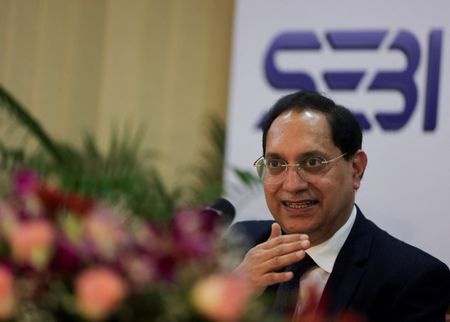By Jayshree P Upadhyay and Nishit Navin
MUMBAI (Reuters) – India’s markets regulator on Friday made it easier for sovereign-backed and overseas retail funds to access the local markets with simplified rules, a move expected to ease access for nearly two-thirds of foreign investors.
The relaxation comes at a time when India has seen foreign outflows gather pace, pressured by steep U.S. tariffs, tepid earnings, and higher equity valuations. So far in 2025, overseas investors have pulled out $11.7 billion from Indian shares and debt.
Through the single-window clearance system, investors seen as low risk will need to provide fewer documents and meet lower compliance requirements.
“This initiative seeks to reduce regulatory complexity, simplify compliance and enhance India’s global competitiveness as an investor-friendly destination,” the Securities and Exchange Board of India said in a statement.
“This is just the beginning,” and a single-window system might be possible for other categories of foreign investors under India’s foreign exchange laws, SEBI Chairman Tuhin Kanta Pandey told reporters.
Overseas investors access Indian markets through multiple routes, with compliance requirements differing based on the type of investor, their structure and the assets they hold.
On Friday, the regulator also reduced the proportion of shares large companies must sell at IPOs and simplified disclosures for low-value transactions between interconnected entities, or so-called related parties.
SMALLER SIZE FOR LARGE IPOs
The markets regulator lowered the proportion of shares large companies looking to list must sell to 2.5% of their share capital from 5%, provided their market capitalisation is more than 5 trillion rupees after the IPO.
This will make it easier for the market to absorb the hefty offerings, according to SEBI.
The regulator has been fast-tracking clearances in the world’s second-largest IPO market, which is expected to notch a record fundraise of about $20 billion in 2025.
The move is expected to benefit large firms looking to go public, including telecom operator Reliance Jio and the National Stock Exchange of India.
SEBI also relaxed rules for large companies to meet the 25% public float requirement.
For companies with a post-listing market capitalisation of 500 billion rupees to 1 trillion rupees ($5.67 billion- $11.33 billion), the time given to meet the public float norm is now five years from three years earlier.
Firms with a market capitalisation of more than 1 trillion rupees will have up to 10 years to comply with the norm if their public shareholding was less than 15% at the time of listing, it said.
CONNECTED ENTITIES
The regulator mandated that low-value transactions between interconnected entities will no longer need disclosure and that only some high-value deals would need shareholder approval.
It will also adopt a “scale-based” approach for shareholders’ approval for such transactions.
For listed companies with a turnover of 200 billion rupees, only related-party transactions above a threshold of 10% of the turnover would need shareholders’ approval, SEBI said.
For firms with a turnover of more than 400 billion rupees, related-party transactions worth more than 50 billion rupees will need approvals. This threshold was much lower at 10 billion rupees.
Other decisions taken by the regulator’s board included tighter governance requirements for stock exchanges, limiting the power of bourse chief executives and appointment of two executive directors to the exchange boards.
SEBI also decided that increasingly-popular real estate investment trusts would be treated as equity, a move that will allow India’s large pool of mutual fund money to be invested in them.
Infrastructure investment trusts will continue to be treated at hybrid instruments.
($1 = 88.2410 Indian rupees)
(Reporting by Jayshree P. Upadhyay in Mumbai and Nishit Navin in Bengaluru; Editing by Vijay Kishore and Mrigank Dhaniwala)











